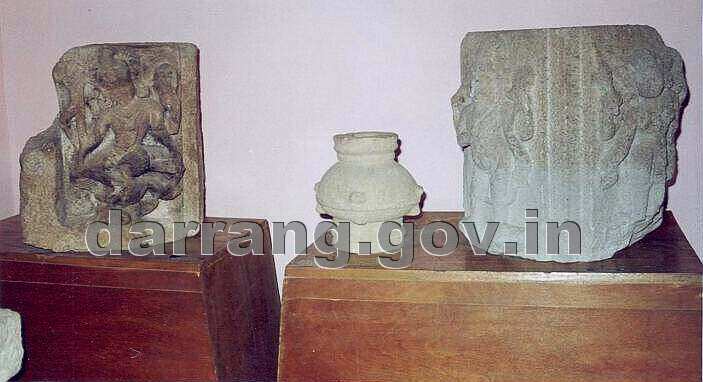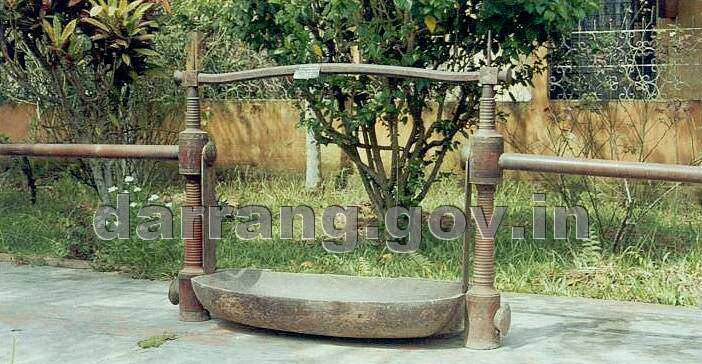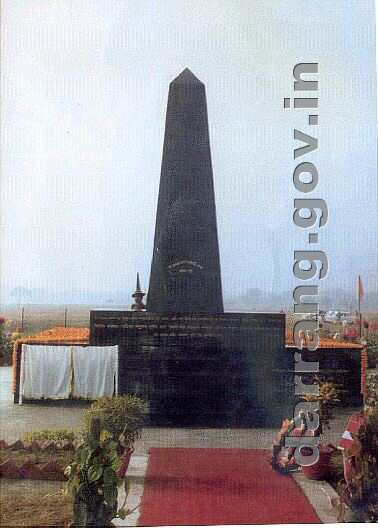DARRANG : AN OUTLINE
The name Darrang seems to
have originated from the Sanskrit word 'Dwaram' which means a
'Duar' or a pass. In the past there were some fixed duars on
the northern side of the district from which the various hill tribes
descended to the plains from the Himalayan ranges. Some of the areas
still have a suffix 'Duar' to their names and one of the six
passes on the northern side of the present district is called 'Khaling
Duar'. Another possible origin of the name is the word 'Devaranga'
which means the playground of Devas. There are a number of places
in the district like Athrikhat, Khalingduar, Dhwalpur,
Markandasram etc. show their ancient association with the mythic
sages like Markedeya, Kaulinya, Atri, Yagyabalka etc.
The name, Mangaldai is,
however traced to Mangola Devi, the daughter of Koch
king Lakshminarayana, who was married to the Ahom king
Pratapsingha. In Yogini Tantra, mention is also made of
the river Mangala which is again referred to as Su-Mangala
in the Kalikapurana. It is thus possible that the name Mangaldai
is derived from the river Mangala Devi. However a parallel
and equally convincing theory says that the name was derived from the
native Bodo dialect, where Mangal means pure and Dai
means water.

Vishnu on Garuda, Decorated Panel and Temple Relic.
Time: 11th century.
Many archaeological sites like Narikali,Tamreswar, Bijulibari, Lakshimpur, Bhairavkunda, Mathajhar, Murhadeor, Dhawalpur,
etc. which have come to light lately, point to a hoary past of this
places. The bronze Bishnu icon of the 11th century, found
at Bijulibari near Sipajhar, now on display at Assam state
Museum and a number of tanks like Jayapal, Burhinagar,
Barampur, Baldev, Dighir, Lakhmpur etc. all stand as evidence
of the ancient glory of Mangaldai.

A Small Canon found at Kharghuli
However, no definitive records about Darrang are available
for the pre-medieval period. According to Dr. Maheswar Neog,
the Darrang become famous only after the middle Age i.e.., up-rising
of the king Biswa Singha Naranarayana. It perhaps formed a part
of the ancient kingdom of Kamrupa and with its decline , Darrang
at different times might have been under the rule of the Chutias,
Bodo-Kacharies and the Bhuyans. However, the picture becomes
somewhat clearer from the 16th century,. In 1581, the famous
Koch king Naranarayan gave a part of his kingdom to his
cousin Raghudev, son of Sukladhwaj best known as 'Chilarai'
for his military powers. Raghudev's part included Mangaldai subdivision
and also the district of Kamrup and Goalpara. This part has been referred to as Koch Hajo or
the kingdom of eastern Koches. Raghudev however did not
exercise any independent authority and he and his successor's attempt
to achieve freedom only got them embroiled in quarrels first with the
Mughals and then with the Ahoms. In the Ahom-Mughal
contest , Balinarayana, another son of Raghudev helped
the Ahom king Pratap Singh (1603-1641) from whom received
the tract known as Darrang. He was feudatory Raja under the Ahom
king who allowed him to rule with the title 'Dharmanarayana'.
Some northern parts of the river Brahmaputra also formed a part of then
Darrang and there he established his capital. It was later on shifted
to Mangaldai during the time of his son and successor Sundarnarayan.
Friction however continued with the Mughals and sometimes with
the Ahoms, but the efforts of the Darrang Rajas to assert independence
did not succeed. During the reign of the Ahom king Gaurinath
Singha (1780-1794), the authority of the Darrang Raja
was further reduced and he was placed at the disposal of the Borphukan
at Guwahati. During this period Raja Krishnanarayan even
tried to secure the British help against the Ahoms which
however did not succeed. Later, the Ahoms lost their former strength
and glory, and having fallen prey to the Burmese attacks, the British
East India company stepped in to draw the curtain.
In 1826 Darrang , like the rest of Assam passed into the
hands of the British after the treaty of Yandabu (Yandabu Sandhi). Having
established their authority, the company Government began the work of
reconstructions and in 1833, Darrang became a district with Mangaldai
as its headquarters. In 1835, the headquarters was shifted to Tezpur.
The same position was maintained until the subdivision of Mangaldai
was converted into a district in 1983.
Darrang has a long history of resistance against any
oppressive rule. That happened during the Ahom period and in the British
period, the people first organised a Rajmel on the assembly of the people
at Patharighat, about 15 kms. west of Mangaldai to protest against the
unreasonable taxation of the Government. At that time (1868), the people
also gheraoed some top ranking officers of the district, but the situation
did not deteriorate because of the intervention of some leading persons.
The great event of 1894, popularly known as 'Patharughatar Ran' (Battle
of Patharughat) is too well known to need any repetition here. On that
fateful day (January 28),some 140 persons belonging to all the communities
lost their lives as a result of unprovoked police firing while protesting
against enhanced revenue. The number of injured was also very high. The
administration did nothing to help the injured or remove the dead bodies.
Patharighat is Assam's Jallianwalabagh.

A Patidola of 18th Century

The Swahid Minar at Patharughat
During the freedom struggle, Darrang also played a
glorious part. People actively participated in the various aspects of
the movement and thereby contributed to the achievement of Indian independence.
The district has also not lagged behind in contributing
to the richness of Assam's culture and civilization. The various temples
and other objects of art though much ravaged by the passage of time,
speak highly of the artistic genius of our craftsmen. Under the patronage
of Darrang Rajas many books on different subjects were also composed.
One such book is Darrang Rajvansavali, written by Suryakhadi Daivagna.
It is a metrical chronicle of Darrang Rajas composed at the initiative
of its tenth ruler Samudranarayana. Ojhapali, a form of sacred dance
drama is still a very popular event in the socio-cultural like of the
people.
Darrang is associated with the famous 'BYAS OJAS'.
Even a village named after Byas Ojas as Byaspara is situated here. Darrang
is also famous for Dhepadhol, Bardhol, Mohkunda song, Suknanni Oja,
Siya Geet etc. which contribute to enrich the colourful heritage of
Assam. We also find many rituals and festivals here, like Deul, Pasati,
Mathani, Gondhchowpari Sabha etc., which reflecr the socio cultural
recreation system of the district. Many aspects of the culture of the
district still remain unexplored.

